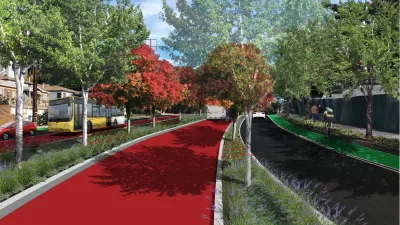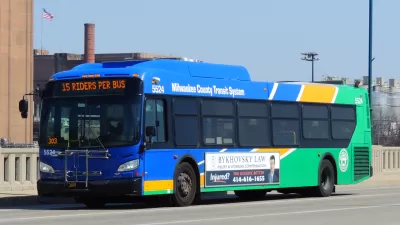In the '90s, Keanu Reeves was hurtling down the roads and freeways of L.A. in a bus; 25 years later, city officials ponder ways to bring the city’s average bus speed above 10 mph.
A lot has changed since the 1994 premiere of Speed, but the big blue buses are still operating. The premise of the movie is that a bomb planted on one of these buses is armed when the bus hits 50 mph, and will detonate if the bus drops below that speed. The plot was always far-fetched, but today, "It’s difficult to envision any vehicle, let alone a bus, reaching and sustaining 50 miles per hour at 8:30 a.m. on the 10 freeway," Elijah Chiland writes for Curbed.
In the quarter century since the film came out, average bus speed in that corridor is down about 3 mph, and costs are up. The buses that serve Santa Monica face worse traffic today than they did in the Speed-era. "As Virginia-based transit analyst Mobility Lab points out, bus riders are generally most impacted by worsening congestion, since even slight delays can create a domino effect that makes buses run behind schedule for much of the day," Chiland reports. When bus routes take longer, it means each vehicle can run the route fewer times. "Bus schedules don’t change when there’s bad traffic, so in order to ensure on-time arrivals, agencies must add more buses to a route as regional congestion worsens," Chiland writes.
The city could address the issue with a congestion pricing scheme or bus rapid transit (BRT) lanes, but neither is an easy sell politically. Though there are already some BRT lanes in the city, BRT works best where there’s already congestion, so while taking away a traffic lane can anger some drivers, asking them to pay congestion pricing can have the same effect. The other option is to let service quality on these buses continue to decline. So far that's the option the city has taken.
FULL STORY: 25 years after ‘Speed,’ can LA get its buses moving again?

Alabama: Trump Terminates Settlements for Black Communities Harmed By Raw Sewage
Trump deemed the landmark civil rights agreement “illegal DEI and environmental justice policy.”

Planetizen Federal Action Tracker
A weekly monitor of how Trump’s orders and actions are impacting planners and planning in America.

The 120 Year Old Tiny Home Villages That Sheltered San Francisco’s Earthquake Refugees
More than a century ago, San Francisco mobilized to house thousands of residents displaced by the 1906 earthquake. Could their strategy offer a model for the present?

Indy Neighborhood Group Builds Temporary Multi-Use Path
Community members, aided in part by funding from the city, repurposed a vehicle lane to create a protected bike and pedestrian path for the summer season.

Congestion Pricing Drops Holland Tunnel Delays by 65 Percent
New York City’s contentious tolling program has yielded improved traffic and roughly $100 million in revenue for the MTA.

In Both Crashes and Crime, Public Transportation is Far Safer than Driving
Contrary to popular assumptions, public transportation has far lower crash and crime rates than automobile travel. For safer communities, improve and encourage transit travel.
Urban Design for Planners 1: Software Tools
This six-course series explores essential urban design concepts using open source software and equips planners with the tools they need to participate fully in the urban design process.
Planning for Universal Design
Learn the tools for implementing Universal Design in planning regulations.
Clanton & Associates, Inc.
Jessamine County Fiscal Court
Institute for Housing and Urban Development Studies (IHS)
City of Grandview
Harvard GSD Executive Education
Toledo-Lucas County Plan Commissions
Salt Lake City
NYU Wagner Graduate School of Public Service





























